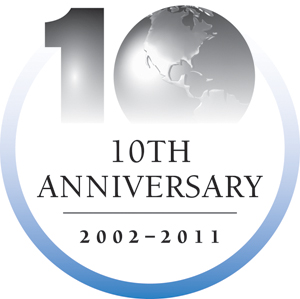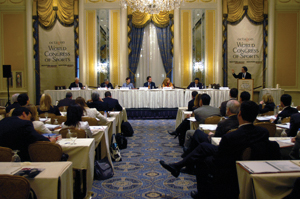 |
RICK FALCO
New York City’s Waldorf-Astoria again played host to the event. |
The event moved back to New York City’s Waldorf-Astoria in 2005, with an overall theme of “The changing face of consumers and sports consumption.”Technology continued to stay top of mind, whether it was ESPN’s use of its sports ticker or looking overseas for a glimpse of what was to come with mobile technology.
Panelists also discussed the problem with steroid use in sports, and the need for the sports business to practice corporate responsibility.
Mobile's youth movement
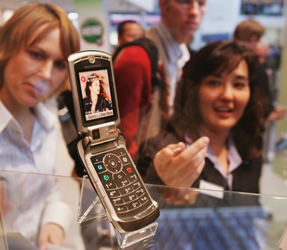 |
GETTY IMAGES
Watching video clips on cell phones was beginning to catch hold in 2005. |
Michael Payne, F1 special adviser to Bernie Ecclestone, spoke from a European perspective on the issue of technology in sports.
“One single medium in Europe is driving sports in the youth market, and it is mobile,” Payne said. “It is not that mobile is replacing television. Television remains king, but in terms of driving audience, driving eyeballs today on your mobile phone throughout most of the European markets and the Japanese market, they are getting the 30-second clips, the previews, the excitement of the event. And for the youth market, if you are not in that space, you have lost already.”
Tracking technology
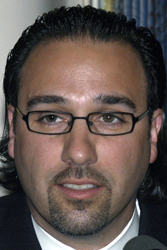 |
| Silva |
As digital technology continued to evolve, panelists wondered about what would have traction with consumers.
Carlos Silva, then AOL’s senior vice president of news and sports, said people should not buy into technology that offers capabilities for which people are more comfortable using their personal computers.
SportsLine.com founder Mike Levy said several hundred wireless companies had
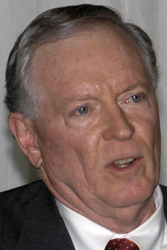 |
| Levy |
received significant funding to produce technology that few people need, and other panelists echoed his claim.
Smartphones later revolutionized the media industry and the way content is delivered to consumers.
Vegas anyone?
The question of placing a professional sports team in Las Vegas surfaced during one discussion.
“I do not think the NFL or MLB fits into Vegas just in terms of demographics,” said Jerry Colangelo, then the CEO of the Phoenix Suns. “I think demographically, an arena with 41 hockey or basketball games would be one of the two.”
Mark Lazarus, Turner Entertainment Group president, said the NBA was the most likely candidate.
“I think the league has shown a progressive stance toward growing their business, and I think they will be the ones that have the courage to do it first.”
Jeremy Jacobs, chairman and CEO of Delaware North and owner of the Boston Bruins, questioned if that scenario would play out.
“They don’t bet a lot on hockey in Vegas,” Jacobs said. “They do bet a lot on basketball, so I don’t see basketball going in. I don’t know if hockey would go, but I know that whoever goes is going to be tremendously successful.”
Several arena projects have since been pitched in Vegas, but neither the NBA nor the NHL are actively reviewing options for Sin City.
Roid rage
 |
GETTY IMAGES
Pitcher Curt Schilling is sworn in while Mark McGwire and Rafael Palmeiro listen during a House committee hearing into steroid use in Major League Baseball, held in March 2005. |
Gary Stevenson, then president and CEO of OnSport, called MLB’s steroids scandal “one of the worst things to happen in sports” in his more than 25 years in business.
Stevenson called out MLB’s corporate partners over their lack of action, saying, “It troubles me that sponsors haven’t taken a stand.”
During a separate panel, Tony Ponturo, then vice president of global media and sports marketing at Anheuser-Busch, also discussed the issue of steroids.
“From an advertiser perspective, the only reason you are sponsoring sports is to align with the quality, integrity and image of these sports,” Ponturo said. “When that is jeopardized, you really have to second-guess that commitment.”
Charitable cause
PGA Tour Commissioner Tim Finchem used his keynote address to discuss corporate responsibility within sports.
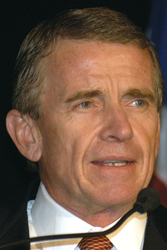 |
Finchem
|
“Ten years ago, it was hard work to get a company to see the benefits of a sporting activity where 100 percent of the net proceeds go back to charity. But the combination of Enron [and smaller stories], and to some extent 9/11, has created a much greater awareness for companies in the position of being part of those activities.”
Despite the charitable component in golf sponsorship, the sport suffered during the current recession as financial companies came under fire for taking government bailout money while spending heavily in sports.
Behold the sports ticker
During one panel that allowed fans to ask questions of industry executives, one fan called ESPN2’s bottom line “distracting.”
However, ESPN’s executive vice president of programming and production at the time, Mark Shapiro, defended the scroll. He said ratings for ESPN2 went up almost 20 percent in the first year after the bottom line was implemented. Still, Shapiro agreed with the fan, saying, “The clutter makes me crazy.”
In more talk about stats packages and on-screen graphics, HBO Sports President Ross Greenburg said, “I have found myself watching NFL football, dare I say, and for some reason I can’t avoid looking up at that right corner to see Cleveland is beating Pittsburgh 7-3 and that Dallas is beating Detroit. And then I keep watching that and there is a goddamn game going on that I am not paying attention to. Well, something is wrong with that picture.”
Shapiro dismissed fans’ annoyance with in-game promotions, saying, “If you have the content, whether you have acquired it or created it, people will come. Yankees-Red Sox. You might not like the promos. You might not like the celebrity interviews, but what is the alternative? Not watching Yankees-Red Sox in the ALCS? Can’t do it.”



